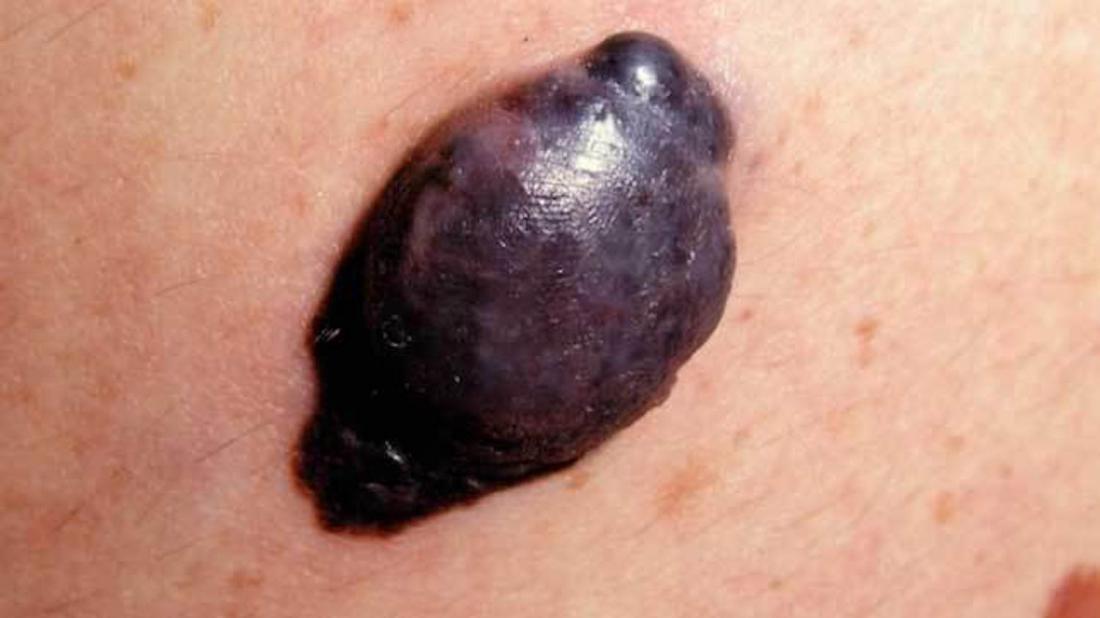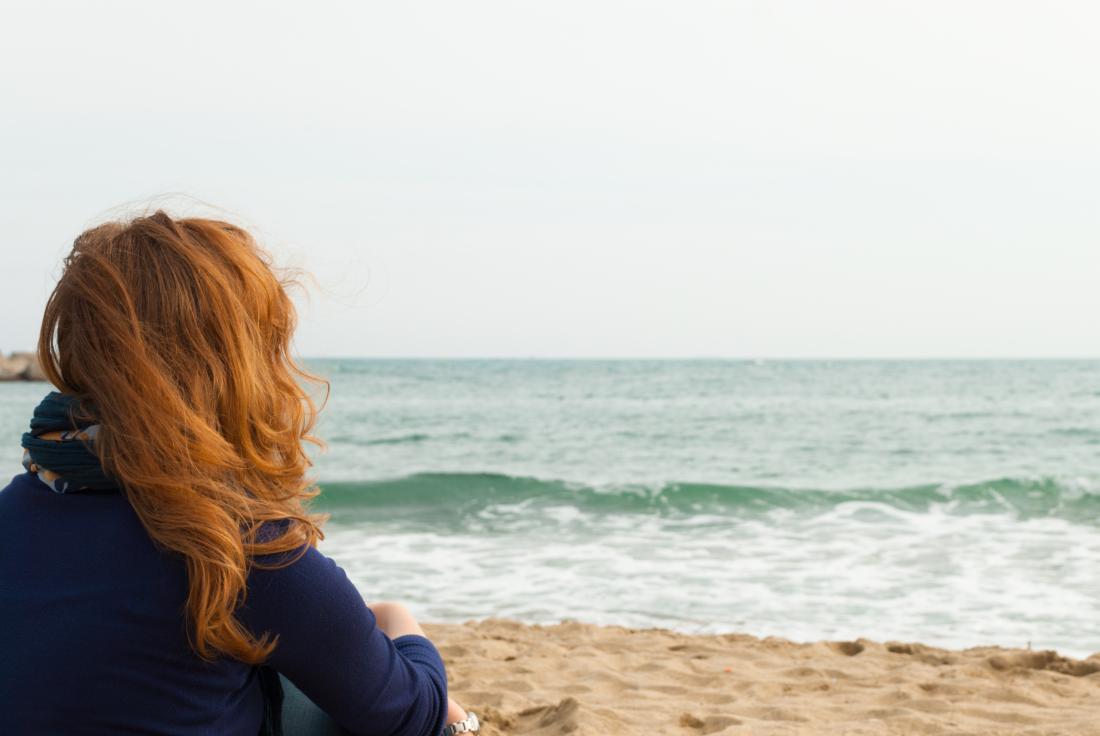This article will explain what nodular melanoma is and describe the symptoms to look out for.
What is nodular melanoma?
Melanoma is the most dangerous form of skin cancer. There are four main types of melanoma.
Nodular melanoma accounts for 15–25 percent of melanoma diagnoses. Compared to the other kinds of melanoma, nodular melanoma grows and spreads more quickly.
It is usually invasive by the time a doctor diagnoses it. This means that it has likely penetrated more deeply into the skin, rather than spreading along the top layer first.
Signs and symptoms of nodular melanoma

Nodular melanoma is usually black.
Image credit: Dermnet New Zealand
Nodular melanoma tends to appear as a growth that sticks out from the skin and looks like a bump.
The medical term for this type of bump is a polypoid. They tend to develop where no moles or lesions existed before.
The bump is usually black, but it may be:
- blue
- gray
- white
- brown
- tan
- red
- the same color as the surrounding skin
A nodular melanoma polypoid can look like a mushroom, with a stem or a stalk. The surface may be smooth, rough, or crusted. It may bleed and will usually feel firm.
Anyone worried about a bump on their skin should speak to a doctor.
Other types of melanoma
Nodular melanoma is one form of this type of skin cancer. The other kinds of melanoma are:
Superficial spreading melanoma
This is the most common form of melanoma, and it usually appears in younger people. It accounts for around 70 percent of all melanoma cases.
Superficial spreading melanoma grows along the top layer of skin for some time before growing more deeply. It is most likely to develop on the trunk in males, on the legs in females, and on the upper back in both sexes.
Lentigo maligna
This kind of melanoma tends to develop in older adults and on areas of skin that have sustained sun damage.
Like superficial spreading melanoma, lentigo maligna grows along the top layer of skin before penetrating deeper.
Acral lentiginous melanoma
This form usually appears as a black or brown patch. A patch may form under the nails, on the soles of the feet, or on the palms of the hands.
Acral lentiginous melanoma also spreads on the surface and then penetrates deeper into the skin.
It is the most common type of melanoma among Asian and African-American people, and the least common among white people.
Causes and risk factors

People with red hair may be at greater risk of developing nodular melanoma.
There is no single cause of cancer, and scientists are often unsure why it develops in some people and not others.
There are several risk factors for skin cancer.
Nodular melanoma is more common in males and in people aged 60 and older. However, it can develop in anyone at any age.
Over 90 percent of melanoma skin cancers result from exposure to harmful ultraviolet (UV) rays. The sun is the main source of these rays, but sunbeds and sunlamps also expose people to them.
UV rays damage the DNA that controls how skin cells divide and grow. This can prevent the cells from repairing themselves correctly, and they may become cancerous as a result.
Melanoma can run in families. Also, a person who has already had a melanoma is more likely to develop another.
Other risk factors include:
- fair skin
- red or blonde hair
- light eyes
- having more than 50 moles
Where on the body is nodular melanoma likely to develop?
Nodular melanoma can appear on any part of the body, but it most commonly develops on the:
- chest
- back
- legs
- face
Diagnosis
Anyone who suspects that they have skin cancer should see a doctor.
First, the doctor will examine the skin and take individual and family medical histories. Be sure to mention any instances of skin cancer.
The doctor will also note other risk factors, such as smoking and sun exposure.
After examining the skin, they will usually also ask:
- when a person first noticed the change in their skin
- whether the skin abnormality has changed in size or appearance
- whether it has bled, or been painful or itchy
The doctor may recommend further tests, such as a biopsy. This involves removing a section of the area of skin and sending it to a lab to check for signs of cancer.
Treatment
The treatment doctors recommend very much depends on the stage of cancer at diagnosis.
Other factors include a person’s age and their level of fitness.
According to the American Cancer Society, surgery is the main treatment option for most melanomas. A person usually receives a general anesthetic for the procedure.
The surgeon will remove the affected area of skin and a small amount of healthy skin around the margins, in an effort to eliminate the cancer completely.
Prevention

Suncreen that protects against UVA and UVB rays is recommended to reduce the risk of skin cancer.
The Melanoma Research Alliance gives the following advice for reducing the risk of skin cancer:
- Wear sunscreen that protects against UVA and UVB rays.
- Sunscreen should have an SPF of at least 30.
- Cover up in the sun with loose clothing, a hat, and sunglasses.
- Avoid the midday sun, when UV rays are the strongest.
- Do not use tanning beds.
- Protect children in the same ways to reduce their risk of developing melanoma.
Outlook and survival
Nodular melanoma is the most dangerous form of skin cancer. It grows and spreads more quickly than other types, and a doctor usually diagnoses it at a later stage.
If melanoma has not spread, the 5-year survival rate is 98.4 percent. This means that fewer than 2 percent of people die within the first 5 years of diagnosis.
If a doctor diagnoses stage 3 melanoma, the 5-year survival rate is 63.6 percent.
If melanoma is in stage 4, it has spread to other parts of the body by diagnosis. In this case, the 5-year survival rate is 22.5 percent.
Researchers continue to work toward improving survival rates for people with melanoma.
Summary
Melanoma is a type of skin cancer, and nodular melanoma is the most aggressive form.
Nodular melanoma usually appears as a small black lump. It is more common in men and people older than 60.
Melanoma often results from exposure to the sun’s harmful UV rays. People should use sunscreen and avoid sunbeds to reduce their risk of skin cancer.
